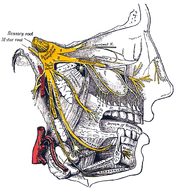Cold-stimulus headache: Difference between revisions
Caspian blue (talk | contribs) For God's sake! How can this image be worthy of the edit wars? leave the image until we get comments on the photo from third party I will upload a cropped vierson |
→Cause and frequency: how much encyclopedic value is there in this picture? |
||
| Line 4: | Line 4: | ||
==Cause and frequency== |
==Cause and frequency== |
||
[[Image:Brainfreeze.jpg|thumb|right|275px|A child attempts to mitigate the effects of an ice-cream headache by putting his hand to his forehead, where the pain appears to come from.]] |
|||
"Ice cream headaches" result from quickly eating or drinking very cold substances. It is commonly experienced when applying ice-cream (or similar) to the roof of the mouth (palate) or when swallowing it.<ref name="Bird1992">{{cite journal |author=Bird, N; MacGregor, EA; Wilkinson, MI |title=Ice cream headache--site, duration, and relationship to migraine |journal=Headache |volume=32 |issue=1 |pages=35–8 |year=1992 |month=January |pmid=1555929 |url=http://www.ncbi.nlm.nih.gov/pubmed/1555929 }}</ref> |
"Ice cream headaches" result from quickly eating or drinking very cold substances. It is commonly experienced when applying ice-cream (or similar) to the roof of the mouth (palate) or when swallowing it.<ref name="Bird1992">{{cite journal |author=Bird, N; MacGregor, EA; Wilkinson, MI |title=Ice cream headache--site, duration, and relationship to migraine |journal=Headache |volume=32 |issue=1 |pages=35–8 |year=1992 |month=January |pmid=1555929 |url=http://www.ncbi.nlm.nih.gov/pubmed/1555929 }}</ref> |
||
Typically the headache appears in about 10 seconds and lasts about 20 seconds, with the pain seeming to relate to the same side of the head as the cold substance was applied to the palate, or to both sides of the head in the case of swallowing.<ref name="Bird1992" /> |
Typically the headache appears in about 10 seconds and lasts about 20 seconds, with the pain seeming to relate to the same side of the head as the cold substance was applied to the palate, or to both sides of the head in the case of swallowing.<ref name="Bird1992" /> |
||
Revision as of 04:21, 26 March 2009

Ice-cream headache, also known as brain freeze, cold headache, shakeache, frigid face, freezie, frozen brain syndrome, cold-stimulus headache, or its given scientific name sphenopalatine ganglioneuralgia (meaning "nerve pain of the sphenopalatine ganglion"), is a form of brief cranial pain or headache commonly associated with consumption (particularly quick consumption) of cold beverages or foods such as ice cream. It is caused by having something cold touch the roof of the mouth (palate), and is believed to result from a nerve response causing rapid dilation and swelling of blood vessels [1] or a "referring" of pain from the roof of the mouth to the head.[2][3] The rate of intake for cold foods has been studied as a contributing factor.[4][5]
Cause and frequency
"Ice cream headaches" result from quickly eating or drinking very cold substances. It is commonly experienced when applying ice-cream (or similar) to the roof of the mouth (palate) or when swallowing it.[6] Typically the headache appears in about 10 seconds and lasts about 20 seconds, with the pain seeming to relate to the same side of the head as the cold substance was applied to the palate, or to both sides of the head in the case of swallowing.[6]
It is the direct result of the rapid cooling and rewarming of the blood vessels in the palate, or the roof of the mouth. A similar but painless blood vessel response causes the face to appear "flushed" after being outside on a cold day. In both instances, the cold temperature causes blood vessels to constrict and then experience extreme rebound dilation as they warm up again.[7]
In the palate, this dilation is sensed by nearby pain receptors, which then send signals back to the brain via the trigeminal nerve, one of the major nerves of the facial area. This nerve also senses facial pain, so as the signals are conducted the brain interprets the pain as coming from the forehead — the same "referred pain" phenomenon seen in heart attacks. Brain-freeze pain may last from a few seconds to a few minutes. Research suggests that the same vascular mechanism and nerve implicated in "brain freeze" cause the aura (sensory disturbance) and pulsatile (throbbing pain) phases of migraines.[8]
As "ice cream headaches" require a warm ambient environmental temperature to occur, it is impossible to suffer one in cold weather.[7]
The phenomena is common enough to have been the subject of research conducted by the British Medical Journal and Scientific American.[7][8]
Classification
The International Classification of Headache Disorders (ICHD) code is 13.11.2 and International Statistical Classification of Diseases and Related Health Problems ICD-10NA code is G44.8021, "Headache attributed to ingestion or inhalation of a cold stimulus".[9]
References
- ^ How stuff works
- ^ Mayo clinic (causation)
- ^ Medterms.com
- ^ Ice cream evoked headaches ICE-H study
- ^ University of Guelph
- ^ a b Bird, N; MacGregor, EA; Wilkinson, MI (1992). "Ice cream headache--site, duration, and relationship to migraine". Headache. 32 (1): 35–8. PMID 1555929.
{{cite journal}}: Unknown parameter|month=ignored (help)CS1 maint: multiple names: authors list (link) - ^ a b c Scientific American Mind, 1555-2284, 2008, Vol. 19, Issue 1. "Brain Freeze." Andrews, Mark A., Lake Erie College of Osteopathic Medicine.
- ^ a b http://bmj.bmjjournals.com/cgi/content/full/314/7091/1364 Ice cream headache - Hulihan 314 (7091): 1364 - BMJ
- ^ "ICHD-II Abbreviated pocket version" (pdf). International Headache Society. 2004. Retrieved 2009-03-25.
